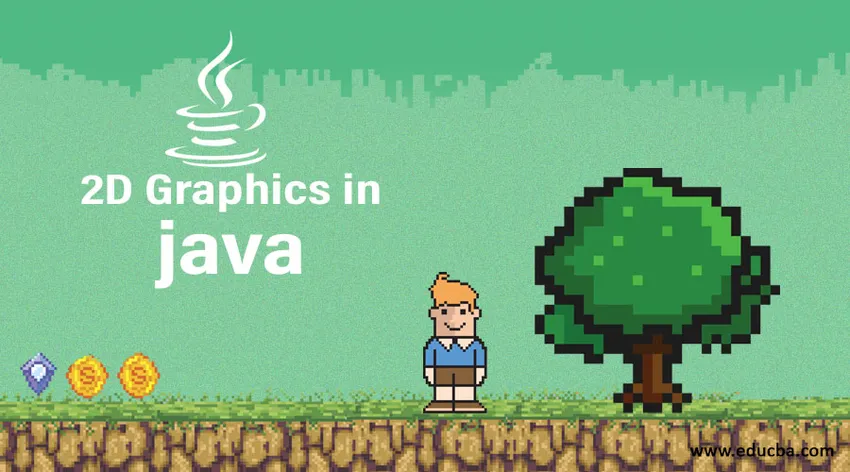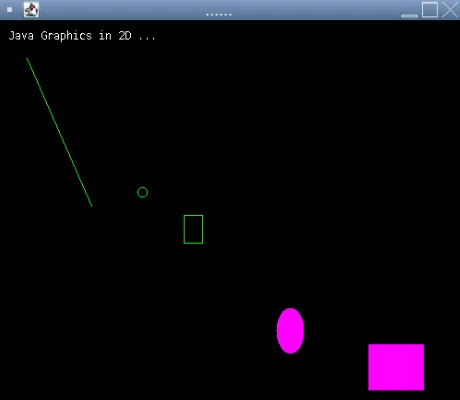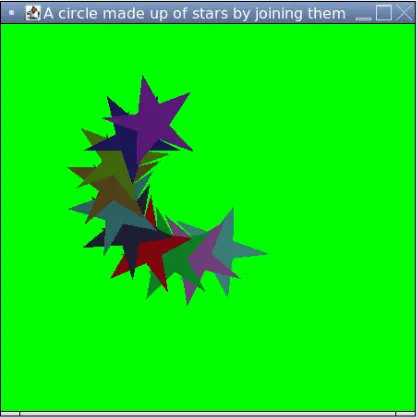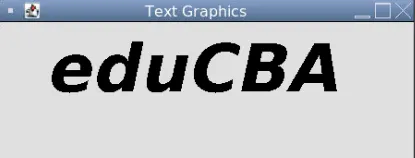
Introduzione alla grafica 2D in Java
Java supporta l'interfaccia di programmazione di applicazioni 2D che consente di creare grafica 2D di altissima qualità. L'API 2D Java è costituita da classi con funzioni o metodi Java predefiniti che consentono al programmatore di eseguire la trasformazione geometrica, l'elaborazione delle immagini, la composizione alfa e molti altri progetti grafici avanzati.
L'API 2D Java fa parte della piattaforma Java 2. Di seguito sono riportati i pacchetti costituiti dall'API 2D:
- AWT
- awt.image
- awt.color
- awt.font
- awt.geom
- awt.print
- awt.image.renderable
L'API 2D Java estende Abstract Windowing Toolkit (AWT) per fornire funzionalità di imaging e grafica bidimensionali. Il pacchetto è costituito da un framework completo per sviluppare una ricca interfaccia utente, programmi di disegno e editor di immagini.
Con l'API 2D Java avrai il supporto per le seguenti funzioni:
- Ti permetterà di stampare documenti complessi.
- Fornisce la gestione del colore con un set migliorato di colori.
- Il pacchetto ha una vasta gamma di disegni geometrici pronti all'uso come curve, quadrati, triangoli, rettangoli
- Il pacchetto ti consente di rendere qualsiasi forma in modo molto intuitivo.
- Per mantenere la stessa qualità durante tutto il processo di progettazione, i suggerimenti di rendering vengono visualizzati ovunque sia richiesto
Fino ad ora abbiamo discusso a un livello molto alto, cos'è l'API 2D e cosa puoi ottenere con questa API. Ora che ne hai un'idea, andiamo in profondità in questa sezione. Una delle parti più importanti è, con Java 2D Rendering, non devi sempre avere a che fare con motivi geometrici primitivi e progettare la tua figura geometrica. Vediamo quindi come funziona il rendering nell'API 2D.
Rendering 2D Java
L'API 2D Java supporta un modello di rendering uniforme su tutti i diversi tipi di dispositivi, sia esso un monitor di visualizzazione o una stampante. Durante lo sviluppo del programma, il rendering funziona allo stesso modo, indipendentemente dal componente finale, che si tratti di una stampante o di un monitor di visualizzazione. Il pacchetto rileva e modifica automaticamente il contesto grafico in base al componente finale. L'API 2D Java è costituita da java.awt.Graphics2D che estende la classe Graphics per fornire supporto per funzionalità grafiche e di rendering avanzate.
Di seguito sono riportate le funzionalità fornite dal pacchetto:
- Supporta il rendering di forme e figure geometriche primitive.
- Fornisce l'opzione per riempire l'interno di qualsiasi forma con qualsiasi colore o motivo specificato negli attributi di disegno usando i tratti.
- Ti permette di renderizzare l'immagine specificata.
- Ti consente di convertire le stringhe di testo in glifi che possono essere riempite con i colori specificati negli attributi di disegno.
Esempio 1
Diamo un'occhiata allo stesso programma Java e vediamo come funziona.
Codice:
import javax.swing.JFrame;
import java.awt.*; // AWT package is responsible for creating GUI
import javax.swing.*; // Java swing package is responsible to provide UI components
// AWT class extents Jframe which is part of Swing package
public class AWTGraphicsSampleProgram extends JFrame (
/**
*
*/
// Defining all the static variables
private static final long serialVersionUID = 1L;
public static final int SAMPLE_CANVAS_WIDTH = 500;
public static final int SAMPLE_CANVAS_HEIGHT = 500;
// The program enters from the main method
public static void main(String() args) (
SwingUtilities.invokeLater(new Runnable() (
@Override
public void run() (
new AWTGraphicsSampleProgram(); // this run method will create a new object and thus invoke the constructor method.
)
));
)
//Here we are creating an instance of the drawing canvas inner class called DrawCanwas
private DrawCanvas sampleCanvas;
public AWTGraphicsSampleProgram() (
sampleCanvas = new DrawCanvas();
sampleCanvas.setPreferredSize(new Dimension(SAMPLE_CANVAS_WIDTH, SAMPLE_CANVAS_HEIGHT));
Container containerPane = getContentPane();
containerPane.add(sampleCanvas);
setDefaultCloseOperation(EXIT_ON_CLOSE); // setting up the default close mechanism
pack();
setTitle("……"); // set the desired title of the JFrame
setVisible(true); // setVisible method will be set the visibility of the Jframe to true
)
/**
* here drawCanvas is the inner class of the Jpanel which is used for custom drawing
*/
private class DrawCanvas extends JPanel (
/**
*
*/
private static final long serialVersionUID = 1L;
// Overriding paintComponent will let you to design your own painting
@Override
public void paintComponent(Graphics graphics) (
super.paintComponent(graphics);
setBackground(Color.BLACK); // setting the background color to black
graphics.setColor(Color.GREEN); // setting up the color to green
graphics.drawLine(30, 40, 100, 200);
graphics.drawOval(150, 180, 10, 10);
graphics.drawRect(200, 210, 20, 30);
graphics.setColor(Color.magenta);
graphics.fillOval(300, 310, 30, 50);
graphics.fillRect(400, 350, 60, 50);
graphics.setColor(Color.WHITE);
graphics.setFont(new Font("Monospaced", Font.PLAIN, 12)); // setting up the font style and font size
graphics.drawString("Java Graphics in 2D …", 10, 20);
)
)
)
Produzione:

La classe grafica offre diversi metodi per disegnare diversi oggetti grafici. I metodi più comuni sono drawString (), drawImage () e fillXxx (). Questi metodi possono essere ampiamente divisi in due categorie. Il primo tipo di metodo grafico è, fornisce funzioni di disegno e riempimento che consentono agli utenti di eseguire il rendering di forme, testo e immagini di base. L'altro tipo di metodo è per le impostazioni degli attributi che consente di modificare l'effetto di come appare il disegno nella console. Metodi come setColor e setFont ti consentono di decidere come eseguire il rendering e il riempimento. Il contesto grafico è responsabile di mantenere lo stato o gli attributi come il colore di pittura corrente, il carattere corrente.
Esempio n. 2
Vediamo un altro esempio di cos'altro possiamo ottenere con le classi 2D Java.
Codice:
import javax.swing.*;
import java.awt.event.*;
import java.awt.*;
import java.awt.geom.*;
import java.awt.image.*;
public class GeometricShapes extends JFrame
(
/**
*
*/
private static final long serialVersionUID = 1L;
@SuppressWarnings("deprecation")
public GeometricShapes()
(
super( "Geometric shapes" );
setSize( 425, 160 );
show();
)
public static void main( String args() )
(
GeometricShapes figure = new GeometricShapes();
figure.addWindowListener( new WindowAdapter()
(
public void windowclosing( WindowEvent e )
(
System.exit( 0 );
)
));
)
public void paint( Graphics graphics )
(
// Instantiating Graphics 2D class
Graphics2D graphics2D = ( Graphics2D ) graphics;
graphics2D.setPaint( new GradientPaint( 16, 30,
Color.red,
45, 105,
Color.green,
true ) );
graphics2D.fill( new Ellipse2D.Double( 6, 31, 61, 105 ) );
graphics2D.setPaint( Color.black );
graphics2D.setStroke(new BasicStroke( 9.0f ) );
graphics2D.draw( new Rectangle2D.Double( 82, 32, 67, 102 ) );
// This will create a black colored rounded rectangle
BufferedImage bufferedImage = new BufferedImage( 10, 10, BufferedImage.TYPE_INT_RGB );
Graphics2D design = bufferedImage.createGraphics();
design.setColor( Color.blue );
design.fillRect( 0, 0, 9, 9 );
design.setColor( Color.orange );
design.drawRect( 2, 2, 7, 7 );
design.setColor( Color.black );
design.fillRect( 2, 2, 4, 4 );
design.setColor( Color.pink );
design.fillRect( 5, 5, 2, 2 );
graphics2D.setPaint( new TexturePaint( bufferedImage, new Rectangle( 9, 9 ) ) );
graphics2D.fill( new RoundRectangle2D.Double( 156, 31, 76, 101, 51, 51 ) );
graphics2D.setPaint( Color.CYAN );
graphics2D.setStroke(new BasicStroke( 7.0f ) );
graphics2D.draw( new Arc2D.Double( 240, 30, 75, 100, 0, 270, Arc2D.PIE ) );
// this will create line in red and black color
graphics2D.setPaint( Color.red );
graphics2D.draw( new Line2D.Double( 400, 40, 350, 180 ) );
float dashesArray() = ( 20 );
graphics2D.setPaint( Color.black );
graphics2D.setStroke( new BasicStroke( 4, BasicStroke.CAP_BUTT, BasicStroke.JOIN_ROUND, 10, dashesArray, 0 ) );
graphics2D.draw( new Line2D.Double( 320, 30, 395, 150 ) );
)
)
Produzione:

Esempio n. 3
Applichiamo Java Java nel seguente programma.
Codice:
import javax.swing.*;
import java.awt.event.*;
import java.awt.*;
import java.awt.geom.*;
public class GeometricShapes2 extends JFrame
(
/**
*
*/
private static final long serialVersionUID = 1L;
public static void main( String args() )
(
GeometricShapes2 design = new GeometricShapes2();
design.addWindowListener(new WindowAdapter()
(
));
)
@SuppressWarnings("deprecation")
public GeometricShapes2()
(
super( "A circle made up of stars by joining them at certain position filled with random colors" );
setBackground( Color. green );
setSize( 450, 450 );
show();
)
public void paint( Graphics graphics )
(
int xCoordinates() = ( 57, 69, 111, 75, 85, 57, 29, 39, 3, 45 );
int yCoordinates() = ( 2, 38, 38, 56, 98, 74, 98, 56, 38, 38 );
Graphics2D graphics2D = ( Graphics2D ) graphics;
GeneralPath starFigure = new GeneralPath();
starFigure.moveTo( xCoordinates( 0 ), yCoordinates( 0 ) );
for ( int j = 1; j < xCoordinates.length; j++ )
starFigure.lineTo( xCoordinates( j ), yCoordinates( j ) );
starFigure.closePath();
graphics2D.translate( 200, 200 );
for ( int i = 1; i <= 10; i++ )
(
graphics2D.rotate( Math. PI / 9.0 );
graphics2D.setColor(new Color( ( int ) ( Math. random () * 128 ), ( int ) ( Math. random () * 128 ),
( int ) ( Math. random () * 128 ) ) );
graphics2D.fill( starFigure );
)
)
)
Produzione:

Esempio n. 4
Applicazione della codifica a colori nel seguente programma.
Codice:
import java.awt.*;
import java.awt.event.*;
import java.awt.geom.*;
public class GeometricShapes3 extends Canvas (
/**
*
*/
private static final long serialVersionUID = 1L;
Frame windowFrame;
TextField sampleText;
Font sampleFont;
Color colorOfText;
Color colorOfCircle;
public static void main(String args()) (
GeometricShapes3 start;
start = new GeometricShapes3();
)
public GeometricShapes3() (
this("Arial", Font.BOLD, 18, Color.gray, Color.red);
)
public GeometricShapes3(String ff, int fs, int fz, Color bg, Color fg) (
setBackground(bg);
colorOfCircle = Color.green.brighter();
colorOfText = fg;
sampleFont = new Font(ff, fs, fz);
sampleText = new TextField("eduCBA (Corporate Bridge Consultancy Pvt Ltd) ");
windowFrame = new Frame("Demo");
windowFrame.add(sampleText, BorderLayout.NORTH);
windowFrame.add(this, BorderLayout.CENTER);
windowFrame.setSize(new Dimension(300, 340));
windowFrame.setLocation(150, 140);
windowFrame.addWindowListener(new WindowAdapter() (
public void windowClosing(WindowEvent we) (
System.exit(0);
)
));
sampleText.addActionListener(new ActionListener() (
public void actionPerformed(ActionEvent ae) (
repaint();
)
));
windowFrame.setVisible(true);
)
public void paint(Graphics graphics) (
String sampleTxt = sampleText.getText();
if (sampleTxt.length() == 0) return;
if (graphics instanceof Graphics2D) (
Dimension dimension = getSize();
Point point = new Point(dimension.width / 2, dimension.height / 2);
int radius = (int)(point.x * 0.84);
graphics.setColor(colorOfCircle);
graphics.drawArc(point.x - radius, point.y - radius,
radius*2-1, radius*2-1,
0, 360);
graphics.setColor(colorOfText);
graphics.setFont(sampleFont);
CircularText((Graphics2D)graphics, sampleTxt, point, radius, -Math.PI/2, 1.0);
)
else (
System.out.println("Some Error Occurred");
)
)
static void CircularText(Graphics2D graphics, String sampleTxt, Point center,
double radius, double length, double height)
(
double circleAngle = length;
Point2D circle = new Point2D.Double(center.x, center.y);
char chArray() = sampleTxt.toCharArray();
FontMetrics fm = graphics.getFontMetrics();
AffineTransform formx, formy;
formx = AffineTransform.getTranslateInstance(circle.getX(), circle.getY());
for(int i = 0; i < chArray.length; i++) (
double cwid = (double)(getWidth(chArray(i), fm));
if (!(chArray(i) == ' ' || Character.isSpaceChar(chArray(i)))) (
cwid = (double)(fm.charWidth(chArray(i)));
formy = new AffineTransform(formx);
formy.rotate(circleAngle, 0.0, 0.0);
String chstr = new String(chArray, i, 1);
graphics.setTransform(formy);
graphics.drawString(chstr, (float)(-cwid/2), (float)(-radius));
)
if (i < (chArray.length - 1)) (
double adv = cwid/2.0 + fm.getLeading() + getWidth(chArray(i + 1), fm)/2.0;
circleAngle += Math.sin(adv / radius);
)
)
)
static int getWidth(char charText, FontMetrics fontMetrics) (
if (charText == ' ' || Character.isSpaceChar(charText)) (
return fontMetrics.charWidth('n');
)
else (
return fontMetrics.charWidth(charText);
)
)
)
Produzione:

Esempio n. 5
Java Java per grafica di testo.
Codice:
import java.awt.*;
import java.awt.event.WindowAdapter;
import java.awt.event.WindowEvent;
import java.awt.font.FontRenderContext;
import java.awt.font.TextLayout;
import java.awt.geom.AffineTransform;
import java.awt.geom.Rectangle2D;
import java.awt.image.BufferedImage;
public class FontsDemo extends Frame (
/**
*
*/
private static final long serialVersionUID = 1L;
public static void main( String() argv ) (
FontsDemo myExample = new FontsDemo( "Text Graphics" );
)
public FontsDemo( String title ) (
super( title );
setSize( 450, 180 );
addWindowListener( new WindowAdapter() (
public void windowClosing( WindowEvent we ) (
dispose();
System. exit ( 0 );
)
) );
setVisible( true );
)
public void paint( Graphics g ) (
Graphics2D graphics = (Graphics2D) g;
FontRenderContext frc = graphics.getFontRenderContext();
Font font = new Font( "Arial", Font. HANGING_BASELINE | Font. BOLD, 72 );
TextLayout tl = new TextLayout( "eduCBA", font, frc );
Shape myShape = tl.getOutline( AffineTransform. getTranslateInstance ( 50, 100 ) );
Paint myPaint = loadTextureResource( "1.gif" );
graphics.setPaint( myPaint );
graphics.fill( myShape );
)
public TexturePaint loadTextureResource( String absfilename ) (
MediaTracker tracker = new MediaTracker( this );
Image imtexture = Toolkit.getDefaultToolkit().getImage( absfilename );
tracker.addImage( imtexture, 0 );
try (
tracker.waitForID( 0 );
int width = imtexture.getWidth( this );
int height = imtexture.getHeight( this );
System. out .println( "width" + width + " height =" + height );
BufferedImage buffImg = new
BufferedImage( width, height, BufferedImage. TYPE_INT_ARGB );
Graphics g = buffImg.getGraphics();
g.drawImage( imtexture, 0, 0, this );
return new TexturePaint( buffImg, new Rectangle2D.Double( 0, 0, width, height ) );
)
catch( Exception e ) (
System. out .println( "Exception on Image-Texture Loading" );
)
return null;
)
)
Produzione:

Conclusione
Ora che abbiamo raggiunto la fine dell'articolo, spero che voi ragazzi abbiate una buona idea di ciò che potete ottenere con la grafica 2D Java. Onestamente, la capacità delle classi 2D Java non si limita a forme e figure semplici, può essere estesa per progettare figure complesse e forme geometriche e dipende principalmente da come state sfruttando le classi e i metodi esistenti.
Articolo raccomandato
Questa è una guida alla grafica 2D in Java. Qui discutiamo l'introduzione alla grafica 2D in Java insieme all'implementazione e all'output del codice. Puoi anche consultare i nostri altri articoli suggeriti per saperne di più -
- Introduzione al software di animazione 2D
- Forme 2D e 3D | I 10 migliori confronti
- Palindrome in Java con codice di attuazione
- Metodi per GridBagLayout in Java